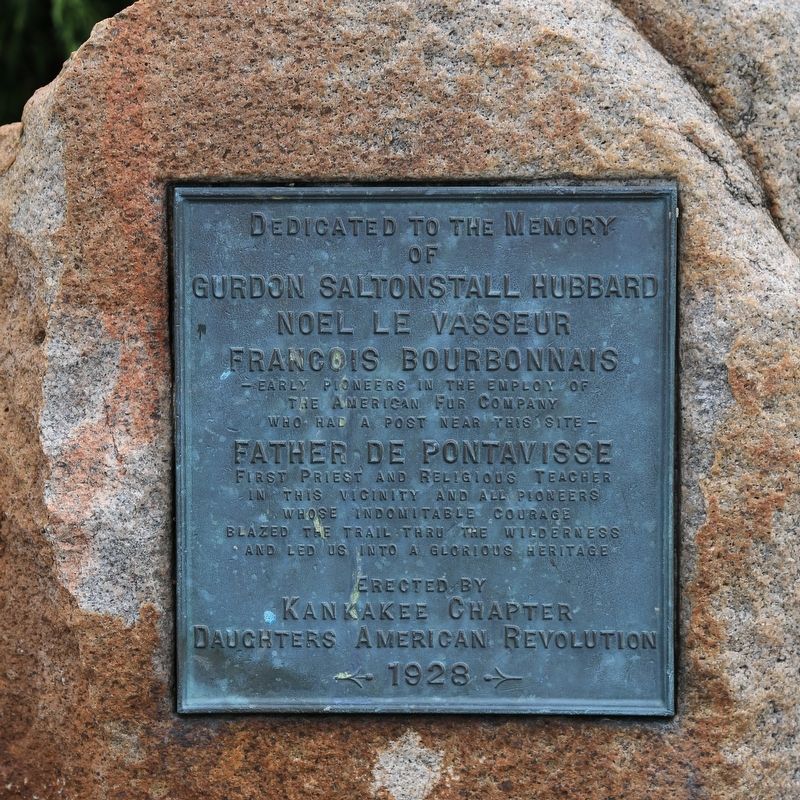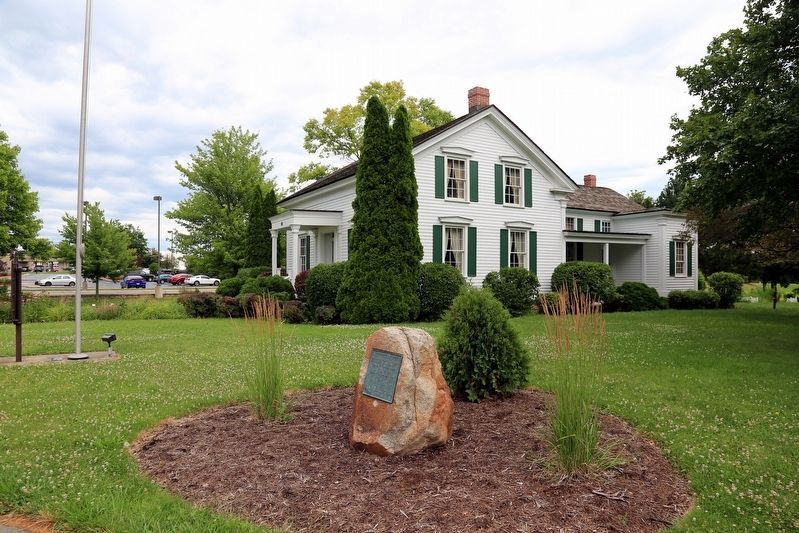Bourbonnais in Kankakee County, Illinois — The American Midwest (Great Lakes)
Dedicated to the Memory
Gurdon Saltonstall Hubbard, Noel Le Vasseur, Francois Bourbonnais
— Father de Pontavisse —
Erected 1928 by Kankakee Chapter, Daughters of the American Revolution.
Topics and series. This historical marker is listed in these topic lists: Education • Settlements & Settlers. In addition, it is included in the Daughters of the American Revolution series list. A significant historical year for this entry is 1830.
Location. 41° 9.485′ N, 87° 53.218′ W. Marker is in Bourbonnais, Illinois, in Kankakee County. Marker is on Straford Drive East just west of Main Street NW (Illinois Route 102), on the left. It is at the Bourbonnais Grove Letourneau Home Museum. Touch for map. Marker is in this post office area: Bourbonnais IL 60914, United States of America. Touch for directions.
Other nearby markers. At least 8 other markers are within 7 miles of this marker, measured as the crow flies. Bourbonnais Grove (here, next to this marker); Jardin aux Potages (within shouting distance of this marker); A Night of Tragedy and Heroism (approx. half a mile away); Noël Le Vasseur (approx. half a mile away); The Durham-Perry Family Legacy (approx. 0.9 miles away); The Durham-Perry Farmstead Home (approx. 0.9 miles away); Durham-Perry Farmstead (approx. 0.9 miles away); Rockville Illinois (approx. 6.1 miles away). Touch for a list and map of all markers in Bourbonnais.
Also see . . .
1. Wikipedia entry for Gurdon Saltonstall Hubbard. “On several trips throughout Illinois, he became the adopted son of Chief Waba of the Kickapoo and married Watseka, niece of Chief Tamin of the Kankakee Potawatomi. After he walked for 75 miles in a single night to warn the town of Danville of an impending raid by Indians, he earned the nickname ‘Pa-pa-ma-ta-be,’ or ‘Swift-Walker.’ When a local Indian tribe questioned his ability to perform this feat, he challenged their champion walker to a race. Hubbard's challenger lost by several miles and was unable to move the next day. Hubbard seemed to be unaffected.” (Submitted on July 16, 2017.)
2. Wikipedia entry for Noel Le Vasseur. “Le Vasseur travelled to Bunkum, Illinois in 1818, where he established a trading post for the American Fur Company. The post was placed
under the supervision of Gurdon Saltonstall Hubbard, and when Hubbard left in 1827, Le Vasseur took over as his replacement. Le Vasseur also married Hubbard’s ex-wife, Watseka (also called Watch-e-kee). He had three children with her, and learned to speak the Potawatomi language.” (Submitted on July 16, 2017.)
3. Wikipedia entry for Bourbonnais, Illinois. “The village is named after François Bourbonnais, Sr., a fur trapper, hunter and agent of the American Fur Company, who had married a Native American woman and arrived in the area near the fork of two major Indian trails and the Kankakee River circa 1830.[5] John Jacob Astor had founded the company in 1808, and when the United States banned foreign (i.e. British and Canadian companies such as the Hudson's Bay Company) from competing in the country after the War of 1812, it grew. By 1830, it had a near monopoly of fur trading in the Midwest, but the number of local trappable wild animals had declined.” (Submitted on July 16, 2017.)
Credits. This page was last revised on July 16, 2017. It was originally submitted on July 16, 2017, by J. J. Prats of Powell, Ohio. This page has been viewed 281 times since then and 23 times this year. Photos: 1, 2. submitted on July 16, 2017, by J. J. Prats of Powell, Ohio.

